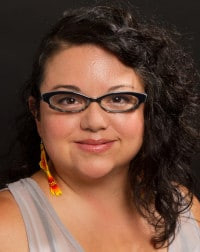Yesenia Hunter’s journey into the heart of Fandango Dance began in Seattle, a city far from its Mexican origins, yet close to her yearning to explore her heritage. Alongside fellow Mexican-American artists, she discovered a dance that resonated deeply with her cultural identity. More than just ancient music, fandango, as Hunter eloquently puts it, is “a living music, in that it belongs to a group of people and to that moment in which it’s being played.”
Originating in Veracruz, Mexico, and deeply intertwined with the spirited son jarocho music of the region, fandango is a captivating blend of dance and music tradition. However, to categorize it merely as entertainment would be to miss its profound essence. Hunter came to understand fandango as a vibrant cultural celebration, a community gathering point where critical social justice issues are often voiced and addressed.
Through her engaging presentations for Humanities Washington’s Speakers Bureau, Yesenia Hunter doesn’t just talk about fandango; she embodies it. Often accompanied by her husband or daughters, she performs the fandango, bringing its dynamic energy and cultural significance to life for audiences across Washington State.
Unveiling the Veracruz Fandango: More Than Just a Dance
While Yesenia Hunter’s upbringing in Guadalajara, Mexico, didn’t immerse her directly in fandango traditions, her adult life led her to embrace this powerful art form. Her initial experiences were with the Seattle Fandango Project, a community of musicians dedicated to son jarocho music and fandango. It was here, starting around 2009, that Hunter began her journey into playing instruments and learning the intricate steps of the dance. This immersion was less about geographical roots and more about connecting with a passionate community celebrating a rich cultural heritage.
Intriguingly, the fandango celebration of Veracruz shares its name with the older fandango dance associated with Spanish flamenco. While both may trace back to shared Spanish musical roots, the Veracruz fandango has evolved into a distinctly unique expression. As Hunter explains, the Veracruz tradition blossomed over the past 300 to 400 years, shaped by a rich tapestry of influences. This fusion includes not only Spanish elements but also significant contributions from indigenous populations and African cultures within Veracruz. This unique blend forged son jarocho music, where the term jarocho itself historically denoted individuals of African or indigenous descent, often from lower social classes engaged in agricultural labor. Their music became an expression deeply connected to the land and nature, and powerfully served as a form of protest throughout Mexican history.
Veracruz: A Port City’s Influence on Fandango’s Fusion
Veracruz’s identity as a bustling port city played a pivotal role in the development of fandango. Historian Antonio Garcia de Leon aptly describes port cities like Veracruz as hubs for “brokers of culture.” These cities became melting pots where diverse cultural elements converged. Influences flowed in not only from Spain and Africa but also from other port cities across the Americas and the United States. This created a fertile ground for the fusion of people, cultures, and musical styles that defines fandango. Furthermore, political dynamics significantly shaped how this music evolved and was expressed.
 Yesenia Hunter, expert in Fandango dance, performing and educating about Mexican cultural traditions.
Yesenia Hunter, expert in Fandango dance, performing and educating about Mexican cultural traditions.
One striking example of this political influence is evident in fandango lyrics. Often playful and imbued with double meanings, some lyrics were explicitly crafted to challenge societal norms and even criticize the Catholic Church. The song “El Chuchembe,” using a folk term for penis, exemplifies this. While set to lively music and dance, the verses cleverly critique priests who preach against premarital sex while engaging in questionable behaviors themselves. These playful verses served as a fun and public way to express dissent and challenge hypocrisy. Similarly, “La Bamba,” another iconic son jarocho song, has been interpreted as a form of protest against forced military service, with lyrics suggesting “I’m not your captain,” signifying resistance to being drafted into war.
Fandango’s Journey North: From Veracruz to the United States
The fandango tradition, historically rooted in Veracruz, has recently expanded its reach, even making its way to Washington State. This migration is part of a broader resurgence of jaraneros – fandango practitioners and enthusiasts – over the last three decades. After a period of decline in the early 20th century due to new technologies and government investment in other art forms that aimed to construct a specific national cultural image of Mexico, fandango experienced a revival. In the 1960s and 70s, young people in Veracruz sought out elders to relearn the tradition, revitalizing fandango as a form of political and cultural activism. From this resurgence, fandango began its journey across borders, finding new communities and audiences in the United States.
Yesenia Hunter’s ongoing presentations across Washington State through Humanities Washington’s Speakers Bureau program exemplify this vibrant expansion. She continues to share the living tradition of fandango dance, ensuring its rhythms and powerful cultural messages resonate far beyond its Veracruz origins.

